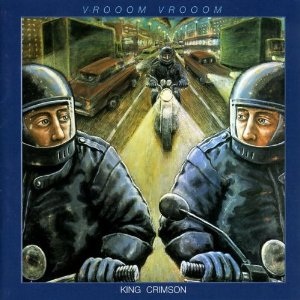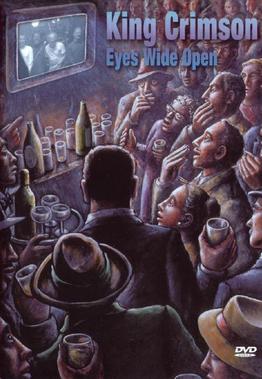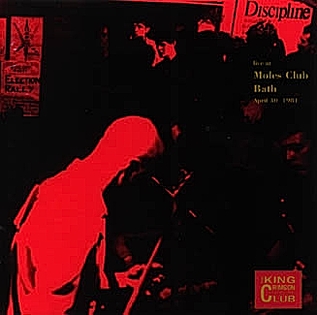
King Crimson were a progressive rock band formed in 1968 in London, England. The band drew inspiration from a wide variety of music, incorporating elements of classical, jazz, folk, heavy metal, gamelan, industrial, electronic, experimental music and new wave. They exerted a strong influence on the early 1970s progressive rock movement, including on contemporaries such as Yes and Genesis, and continue to inspire subsequent generations of artists across multiple genres. The band earned a large cult following.

Larks' Tongues in Aspic is the fifth studio album by the English progressive rock group King Crimson, released on 23 March 1973 through Island Records in the UK and Atlantic Records in the United States and Canada. This album is the debut of King Crimson's third incarnation, featuring co-founder and guitarist Robert Fripp along with four new members: bass guitarist and vocalist John Wetton, violinist and keyboardist David Cross, percussionist Jamie Muir, and drummer Bill Bruford. It is a key album in the band's evolution, drawing on Eastern European classical music and European free improvisation as central influences.

The Construkction of Light is the twelfth studio album by English band King Crimson, released in May 2000 by record label Virgin. It is the first of two studio albums to feature the “double duo” line-up of Robert Fripp, Adrian Belew, Trey Gunn and Pat Mastelotto. It is the only King Crimson studio album to not chart in the US.

Heavy ConstruKction is a live three CD set by the band King Crimson, released by Discipline Global Mobile records on November 7, 2000. The album features recordings of the European tour of May to July 2000, from DATs made at the front-of-house mixing desk.

King Crimson On Broadway is a live album by the band King Crimson, released through the King Crimson Collectors' Club in July 1999. The tracks on the albums were recorded at the Longacre Theater in New York City, New York, US, on November 20, 21, 22, 24 and 25, 1995, as the band was touring to promote the album THRAK.

The Night Watch is a live album by the English rock band King Crimson, recorded in Amsterdam in 1973, and released in 1997.

B'Boom: Live in Argentina is a live album by the band King Crimson, released in 1995. All songs were recorded between 6 and 16 October 1994 at the Broadway Theatre in Buenos Aires, Argentina, except for "Heartbeat" which was recorded in Córdoba.

EleKtrik: Live in Japan is a live album by the band King Crimson, released in 2003. It consists of most of the audio soundtrack from the first disc of the band's double DVD Eyes Wide Open.

Live in Mexico City is a live album by band King Crimson, first released as a free Windows Media Audio download in 1999. Some tracks later appeared on the live albums Cirkus: The Young Persons' Guide to King Crimson Live (1999) and Vrooom Vrooom (2001), and as part of the expanded "THRAK BOX" in 2015. The album was recorded at the Metropolitan Theater, Mexico City, Mexico, 2–4 August 1996

Frame by Frame: The Essential King Crimson is a 4-CD box set by the band King Crimson, released in 1991.
Jamie Muir is a Scottish painter and former musician, best known for his work as the percussionist in King Crimson from 1972–1973, appearing prominently on their fifth album Larks' Tongues In Aspic.

Cirkus: The Young Persons' Guide to King Crimson Live is a live album compilation from King Crimson. It was released in 1999 through Virgin Records.
"Fallen Angel" is a composition by English progressive rock band King Crimson. It is the second track on their seventh studio album, Red, released on 6 October 1974.

The 21st Century Guide to King Crimson – Volume One – 1969–1974 is the first of two 4-CD sets of compilation albums, showcasing the entire production of the British progressive rock band King Crimson. This set of discs contains both studio and live performances ranging from the beginnings of the band in 1969 to their first dissolution in 1974.

The 21st Century Guide to King Crimson – Volume Two – 1981–2003 is a compilation album by the highly influential English progressive rock band King Crimson, containing the best-known songs from the group's 1981–2003 phase. No material from the album the construKction of light (2000) was included in this box set. It was released in 2005.

The Great Deceiver is a 4-CD box set by the band King Crimson, consisting of live recordings from 1973 and 1974, released on Virgin Records in 1992. In 2007, it was reissued on Fripp's Discipline Global Mobile label as two separate 2-CD sets, each featuring new artwork. The box set is titled after a song from the group's 1974 album Starless and Bible Black.

Vrooom Vrooom is a live two CD set by the band King Crimson, recorded in 1995 & 1996, and released in 2001. It features the six member “double trio” lineup of the band, with guitarists Robert Fripp and Adrian Belew, bassists Tony Levin and Trey Gunn, and drummers Bill Bruford and Pat Mastelotto.

Live at the Orpheum is a live album by the band King Crimson, released by Discipline Global Mobile records in 2015. The album was recorded on 30 September and 1 October at the Orpheum Theatre in Los Angeles, California on the band's The Elements of King Crimson US tour of 2014.

Eyes Wide Open is a live 2-DVD set by the British progressive rock band King Crimson, released in 2003. It presents two concerts filmed in the early 2000s, the band lineup featuring Robert Fripp, Adrian Belew, Trey Gunn and Pat Mastelotto.

Discipline: Live at Moles Club, Bath 1981 is a live album by the band King Crimson, the 11th album released through the King Crimson Collectors' Club in June 2000. The original release of this album is credited to "Discipline" which was the original name of this lineup before it was changed to King Crimson.



















